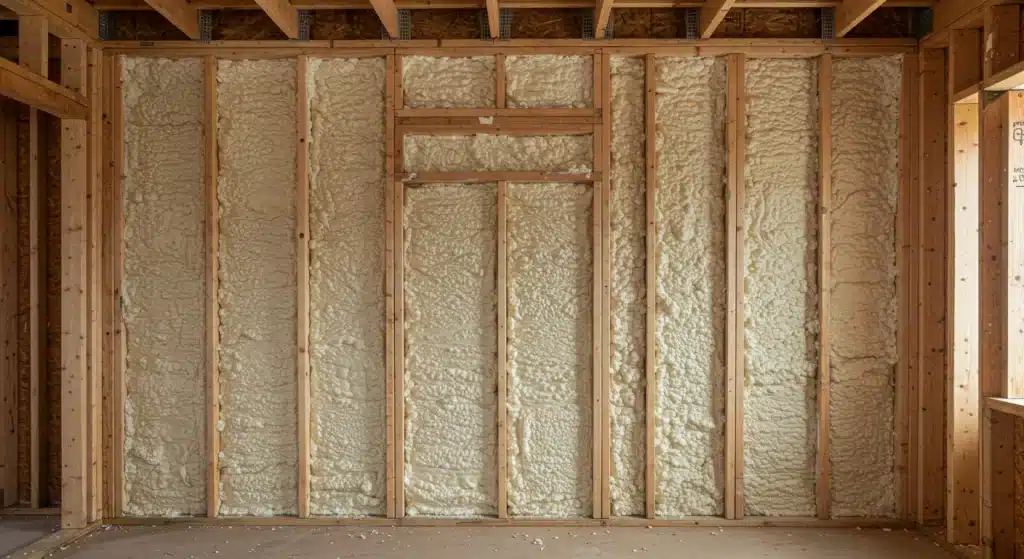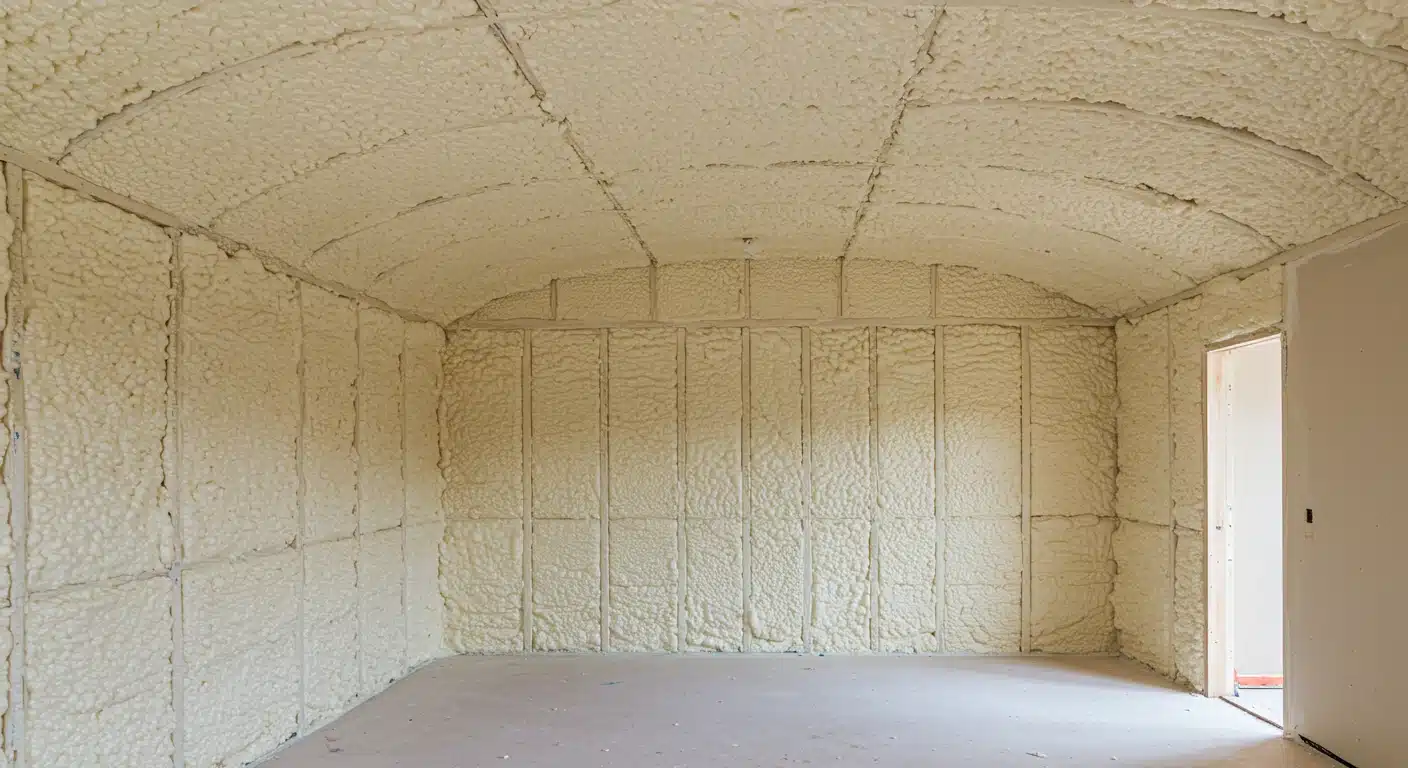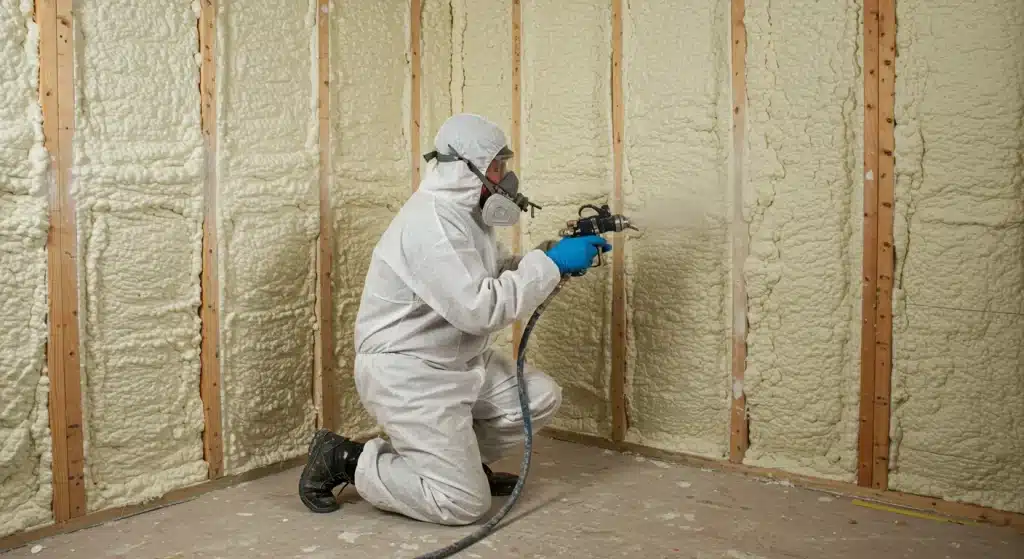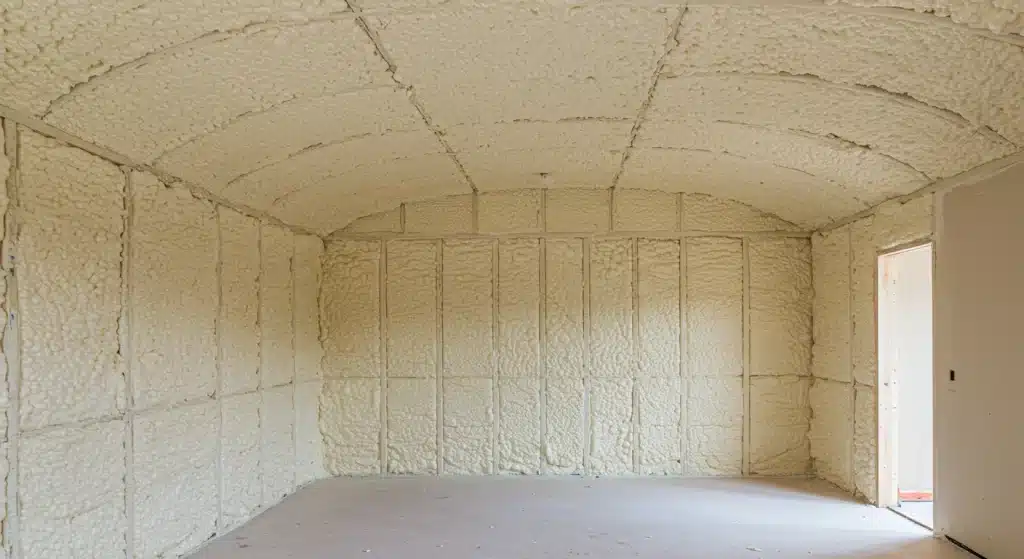Open-cell spray foam insulation is a highly effective tool for preventing ice dams. It works by creating a complete air barrier on the underside of the roof deck. This application stops the warm, moist air from inside your home from ever reaching the cold roof sheathing. When the roof deck stays cold, the snow on top doesn’t melt from underneath. This breaks the melt-and-refreeze cycle that forms destructive ice dams at the eaves and gutters.
This article explains the mechanics behind ice dam formation and details how open-cell spray foam offers a permanent solution. The information is based on extensive field experience in building science and insulation applications, providing a clear guide to protecting your home.
The Science Behind Ice Dam Formation
Ice dams don’t form because of faulty gutters or too much snow. They are a direct result of heat escaping from a home’s living space into the attic. This process happens in a few clear steps:
- Heat Loss: In a poorly insulated and air-sealed attic, warm air rises from heated rooms below. This air easily passes through gaps around light fixtures, plumbing stacks, attic hatches, and through insufficient traditional insulation.
- Snow Melt: The escaped heat warms the underside of the roof deck. Even if the outdoor temperature is well below freezing, the roof surface gets warm enough to melt the layer of snow sitting on it.
- Water Runoff: The melted snow, now water, runs down the slope of the roof underneath the snowpack.
- Refreezing: As the water reaches the colder edges of the roof (the eaves and overhangs), which are not heated from below, it refreezes. This process repeats, slowly building up a thick ridge of ice.
- Water Backup: The ice ridge, or “dam,” stops water from draining off the roof. Water pools behind it, and with nowhere else to go, it can back up under shingles and leak into the attic and exterior walls, causing significant water damage. According to a report from the Insurance Information Institute, water damage is one of the most common and costly homeowner insurance claims.
How Open-Cell Spray Foam Provides a Solution
Applying open-cell spray foam directly to the underside of the roof sheathing fundamentally changes the attic environment and stops ice dams before they can start. Instead of just slowing heat transfer like traditional insulation, it creates an airtight seal.
This method works by creating what is known as a conditioned, or unvented, attic. The attic space is brought inside the home’s thermal boundary, keeping it close to the temperature of the rest of the house. Because the roof deck is now sealed from interior heat and humidity, it stays at the same temperature as the outdoor air. A cold roof deck won’t melt snow, which is the key to preventing ice dams. Building science experts like those at Building Science Corporation confirm that the main strategy to make roofs free from ice dams is the elimination of air movement, especially exfiltrating air in cold climates.
Key Characteristics of Open-Cell Foam
- Air Impermeability: This is its most important feature for stopping ice dams. It expands to fill every crack and gap, creating a monolithic barrier that prevents warm air convection. Traditional insulation like fiberglass batts cannot stop air movement effectively.
- Vapor Permeability: Open-cell foam allows water vapor to pass through it. This is a critical safety feature for a roof assembly. If a roof leak were to occur, the foam’s permeability allows the sheathing to dry out, reducing the risk of wood rot. It also makes leaks easier to spot.
- Insulating Value: While its R-value is lower than closed-cell foam, it provides sufficient thermal resistance to prevent heat conduction when installed at the proper thickness.
Bonus Tip: Before applying spray foam, it is essential to have a roofing professional inspect your roof. Any existing leaks must be repaired completely, as the foam is an insulation product, not a roofing repair material.
Comparing Insulation Options for Roof Decks
Different insulation types offer varying levels of effectiveness when it comes to preventing ice dams. The primary difference lies in their ability to act as an air barrier.
| Feature | Open-Cell Spray Foam | Closed-Cell Spray Foam | Fiberglass/Cellulose |
|---|---|---|---|
| Air Sealing | Excellent (forms a complete air barrier) | Excellent (forms a complete air barrier) | Poor (allows significant air leakage) |
| R-Value/Inch | R-3.5 to R-3.8 | R-6.0 to R-7.0 | R-2.2 to R-3.8 |
| Vapor Control | Permeable (allows drying) | Impermeable (acts as a vapor barrier) | Permeable |
| Application | Sprayed directly to roof deck | Sprayed directly to roof deck | Blown-in or laid in batts on attic floor |
As the table shows, both types of spray foam are superior air sealers. Open-cell is often preferred for roof decks in many climates because its vapor permeability adds a layer of safety for the roof structure.
Things to Consider Before Making a Decision
Choosing to install open-cell spray foam in your attic is a significant home improvement project. Here are a few factors to think about:
- Roof Health: Your roof must be in good condition. Spray foam lasts for the life of the building, so you want to ensure the roof it’s applied to is sound.
- Ventilation Changes: Applying foam to the roof deck means sealing off existing attic vents, such as soffit and ridge vents. This conversion to an unvented attic assembly is a standard practice recognized by building codes, but it’s a permanent change.
- Professional Installation: The performance of spray foam is entirely dependent on the quality of the installation. An experienced, certified installer is necessary to ensure a continuous, airtight seal with the correct thickness.
- Upfront Cost: The initial investment for spray foam is higher than for traditional insulation. However, this cost is often offset by long-term energy savings and the prevention of expensive repairs from ice dam damage. The U.S. Department of Energy notes that air sealing provides significant energy savings, which contributes to the return on investment.
Bonus Tip: Ask your installer about any potential impact on your shingle warranty. Many roofing manufacturers now explicitly approve the use of their products over unvented attics, but it’s always wise to confirm.

FAQS
What is the primary cause of ice dams?
Ice dams are caused by an uneven roof temperature. When the upper part of the roof is warm enough to melt snow (above 32°F) and the lower edge is below freezing, ice dams form. This temperature difference is almost always caused by heat escaping from the home into the attic.
Can’t I just use heating cables to get rid of ice dams?
Heating cables are a temporary fix that only addresses the symptom, not the cause. They melt channels for water to drain, but do nothing to stop the heat loss that causes ice dams in the first place. They also consume a significant amount of electricity.
Is closed-cell foam better for preventing ice dams?
Both open-cell and closed-cell foam are excellent at preventing ice dams because they both create an air seal. Closed-cell foam has a higher R-value and acts as a vapor barrier, which may be suitable for certain climates or applications. However, open-cell’s ability to let the roof assembly dry is a valuable feature.
How thick does the open-cell spray foam need to be?
The required thickness depends on your local building code and climate zone. An insulation professional will calculate the correct depth to provide the necessary R-value and ensure complete air sealing for your specific location.
How does this affect attic temperature in the summer?
By insulating the roof deck, a conditioned attic will be warmer than the living space but significantly cooler than a traditional vented attic, which can reach extreme temperatures. This can reduce the load on your HVAC system.
Final Considerations
Open-cell spray foam provides a reliable, long-term solution to ice dam problems by addressing their root cause: uncontrolled air leakage and heat loss. Creating a conditioned attic space keeps the roof deck cold and stops the cycle of melting and freezing. Before moving forward, evaluate your roof’s condition, understand the installation process, and consider the long-term benefits for your home’s durability and energy efficiency.
Get a Professional Assessment
To determine if open-cell spray foam is the right solution for your home, it’s best to consult with experienced professionals. For a comprehensive evaluation and expert advice, contact the team at Supreme Spray Foam LV. You can discuss your situation by calling (702) 904-9895 or by sending an email with your questions to [email protected]. Proper insulation is key to protecting your home’s value and structural integrity.
Sources
- U.S. Department of Energy – Offers objective information on different insulation types, their properties, and their role in energy conservation.
- Building Science Corporation – Building Science Digest 102 on attic ventilation, confirming the main strategy for ice dam control is the elimination of air movement.






